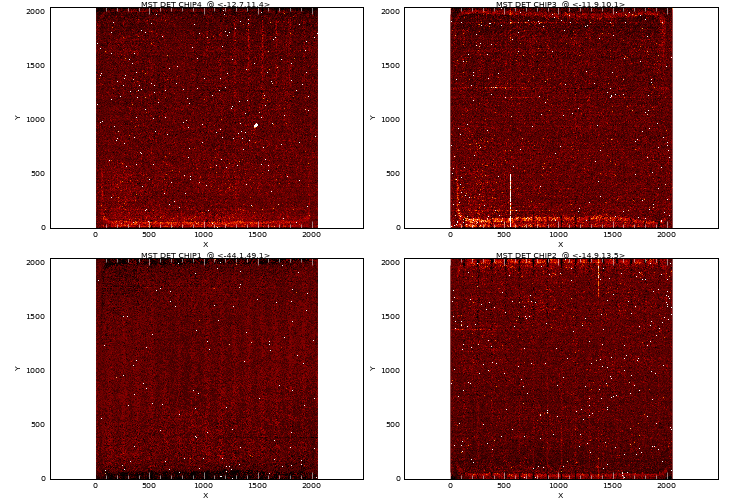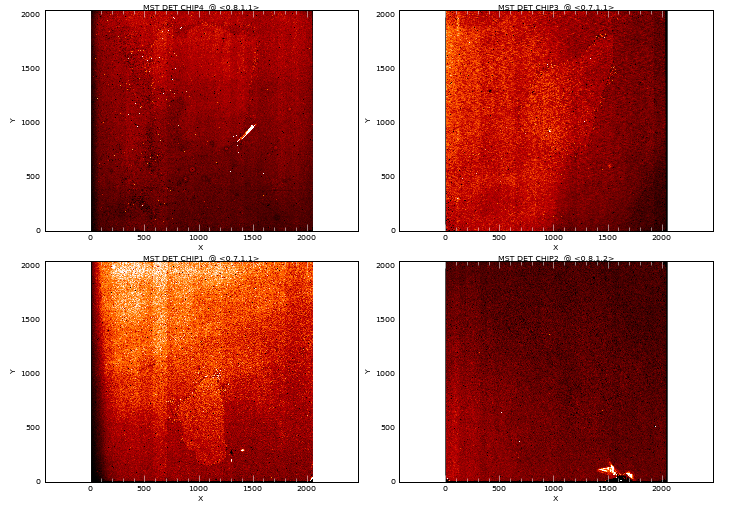 mirror sites:
PL (internal link)
HQ
[?]
mirror sites:
PL (internal link)
HQ
[?]
Quality Control and
Data Processing
|
HAWKI: Calibration recipes
DARK frames: hawki_dark_combine DPR.CATG = CALIB, DPR.TYPE = DARK, DPR.TECH = IMAGE
Dark exposures are obtained regularly to monitor the status of the detector array. They can also be used to subtract the dark current in science frames. Each dark stack consists of 10-15 raw frames. They are combined into one master dark product and quality-checked by QC Garching.
The pipeline recipe hawki_dark_combine (new with pip. 2.0, was hawki_cal_dark) combines raw darks (usually 10) by median-stacking.
The pipeline measures median values, read noise and the standard deviation of the input frames.
 FLAT frames: hawki_twilight_flat_combine
FLAT frames: hawki_twilight_flat_combine
DPR.CATG = CALIB, DPR.TYPE = FLAT, DPR.TECH = IMAGE
HAWK-I flat fields are measured on sky usually at the beginning of the night, at twilight. The clear skies are required for the calibration of SCIENCE data. HAWK-I instrument does not have an internal lamp. In the infrared, twilight flats are taken in a manner of sampling a large flux range by integrating on the twilight sky as the sun sets or rises. Twilight flats are therefore, one of the most time critical calibrations, since of the narrow time window. This is also the reason why more operational related quality parameters like the covered flux range are monitored for twilight flat calibrations. The twilight flats are used to determine the standard deviations of the pixel values of each detector.
The pipeline recipe, hawki_twilight_flat_combine (new with v.2.0, was hawki_cal_flat) operates on stack of frames. First, the recipe subtracts a master dark frame from each input raw flat. Then traces of the stars are removed (second pass) and the master flat is normalised by its median level. Bad pixels are defined as those with values outside given thresholds in the normalised frames.
The pipeline measures the mean flux of the input raw frame, the standard deviation of the product, and the total number of bad pixels.
 DETLIN frames: detmon_ir_lg)
DETLIN frames: detmon_ir_lg)
DPR.CATG = CALIB, DPR.TYPE = DARK,DETCHEK, DPR.TECH = LINEARITY,LAMP or DPR.CATG = CALIB, DPR.TYPE = FLAT,LAMP,DETCHEK, DPR.TECH = LINEARITY,LAMP
A series of DARK and FLAT exposures with increasing DIT to measure non-linearity and gain.
For the non-linearity determination, the pipeline recipe first subtracts from each flat frame the corresponding dark exposure with the same DIT. Then, for each pixel the function ADU = A + B * DIT + C * DIT^2 is fit. The B coefficients basically reflect the unknown intensity of the flat-field lamp whereas deviations from linearity are measured via the C coefficients. The output of the recipe consists of 3 images for the A, B, and C coefficients, respectively, which are stored in one product (LINGAIN_COEFFS).
The pipeline reports median values for the coefficients and an effective non-linearity correction at a given exposure level.
 STD frames: hawki_standard_process
STD frames: hawki_standard_process
DPR.CATG = CALIB, DPR.TYPE = STD, DPR.TECH=IMAGE
HAWK-I standard star observations are taken each night the science observations are acquired. They are used for monitoring the overall instrument efficiency.
Standard stars are processed by the recipe hawki_standard_process (new with v.2.0, was hawki_cal_zpoint). Each standard star observation in one filter consists of four RAW data files, where the standard star is placed at the center of each detector sequentially. This pattern was required by the old version of pipeline, With the new, CASU written pipeline, it is no longer needed but was inherited and is still used. The computed zeropoint, corrected for atmospheric extinction and the maximum counts in ADU in the standard star are monitored for each detector.
Extinction corrected zeropoints, source peak value, over and underexposed input frames
|
||||||||||||||||||||||||||||||||||||||||||||||||||||||||||||||||||||||||||||||||||||||||||||||||||||||||||||||||||||||||||||||||||||||||||||||||||||||||||||||||||||||||||||||||||||||||||||||||||||||||||||||||||||||||||||||||||||
| |
|||||||||||||||||||||||||||||||||||||||||||||||||||||||||||||||||||||||||||||||||||||||||||||||||||||||||||||||||||||||||||||||||||||||||||||||||||||||||||||||||||||||||||||||||||||||||||||||||||||||||||||||||||||||||||||||||||||
 |
|
||||||||||||||||||||||||||||||||||||||||||||||||||||||||||||||||||||||||||||||||||||||||||||||||||||||||||||||||||||||||||||||||||||||||||||||||||||||||||||||||||||||||||||||||||||||||||||||||||||||||||||||||||||||||||||||||||||


